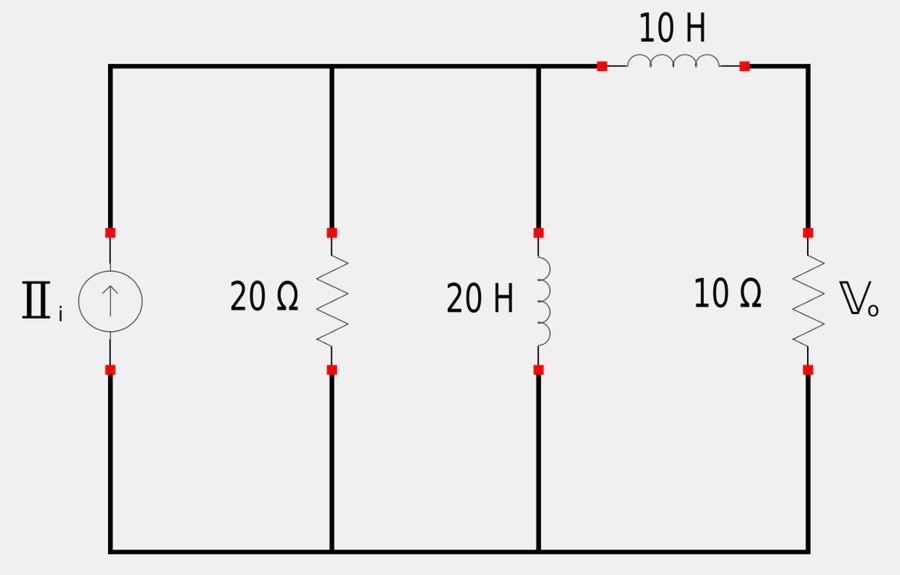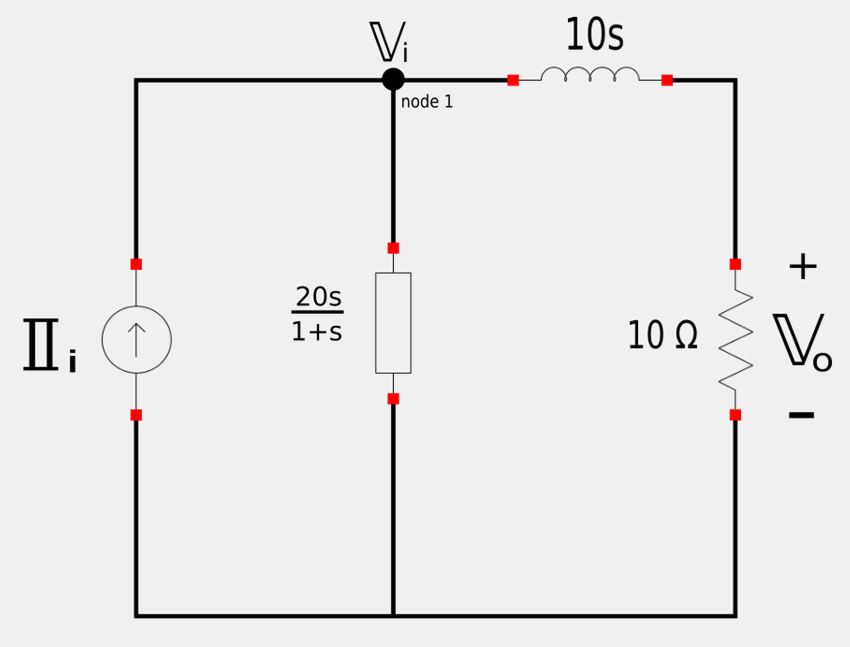Given the following circuit:

Determine: $$ \mathbb{H}(s) = \frac{\mathbb{V}_o(s)}{\mathbb{I}_i(s)} $$
From the previous page, recall the steps that we need to take in order to determine the transfer function
Transform the circuit from time domain to frequency domain:
We begin by determining the imedance values for the appropriate components. Since omega is not known, there will be a "jw" term in each impedance value. We will go ahead and replace the "jw" term with "s". Additionally, we use the law of impedances in parallel to reduce the circuit to the following:

Apply Kirchhoff's Current Law (KCL) at node 1:
Doing so gives us: $$ \frac{\mathbb{V}_i}{\frac{20s}{1+s}} + \frac{\mathbb{V}_i}{10+10s} = \mathbb{I}_i $$ $$ \mathbb{V}_i \Big[ \frac{1+s}{20s} + \frac{1}{10+10s} \Big] = \mathbb{I}_i $$ $$ \mathbb{V}_i \Big[ \frac{(10+10s)(1+s)+20s}{20s(10+10s)} \Big] = \mathbb{I}_i $$ $$ \mathbb{V}_i \Big[ \frac{10+20s+10s^2+20s}{200s^2+200s} \Big] = \mathbb{I}_i $$ $$ \mathbb{V}_i \Big[ \frac{10s^2+40s+10}{200s^2+200s} \Big] = \mathbb{I}_i $$ $$ \mathbb{V}_i \Big[ \frac{s^2+4+1}{20s^2+20s} \Big] = \mathbb{I}_i $$ $$ \mathbb{V}_i = \mathbb{I}_i \Big[ \frac{20s^2+20s}{s^2+4+1} \Big] \qquad, (Eqn\;1) $$
Use the principle of voltage division:
Using voltage division we have the following: $$ \mathbb{V}_o = \Big[ \frac{10}{10+10s} \Big] \; \mathbb{V}_i $$ We now substitute equation #1 into the above expression and get: $$ \mathbb{V}_o = \Big[ \frac{10}{10+10s} \Big] \Big[ \frac{20s^2+20s}{s^2+4+1} \Big] \mathbb{I}_i $$ $$ \mathbb{V}_o = \Big[ \frac{10}{10+10s} \Big] \Big[ \frac{(10+10s)2s}{s^2+4+1} \Big] \mathbb{I}_i $$ $$ \mathbb{V}_o = 10 \Big( \frac{2s}{s^2+4+1} \Big) $$
$$ \frac{\mathbb{V}_o(s)}{\mathbb{I}_i(s)} = \frac{20s}{s^2+4+1} $$ ...where: $$ s = j\omega $$
